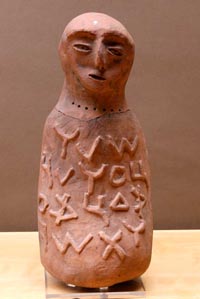

April 2021
Vol. 9, No. 4
My Meeting with Mellaart or, Dutch Cigars and the Case of the Missing Wall Paintings
By Alex Joffe

James Mellaart.
As a young and arrogant graduate student in the 1980s I had a way of barging in unannounced on famous archaeologists. So it was in 1987 or so that I knocked on a door at the Institute of Archaeology at University College London. A short and roundish man answered. This was James Mellaart, famed excavator of the even more famous Neolithic site of Çatalhöyük.
I introduced myself and was politely received. Though he was most famous for his work on the Neolithic, I wanted to talk to him about his views on the fifth-fourth millennia BCE. Perhaps fortuitously he had a class soon but could speak after. He invited me to attend.
And this was when I learned of the unpublished Çatalhöyük wall paintings. Many had been excavated and published in the early 1960s but somehow drawings of others had appeared during the 1980s, and these were the subject of his talk.
I no longer have my notes but I recall lots of animals and birds, geometric designs, an erupting volcano, and ‘goddesses.’ Mellaart rather bubbled over when he spoke of their large breasts and perhaps should have been a clue. A more obvious clue was that there were no photos of these wall paintings, only line drawings and reconstructions.

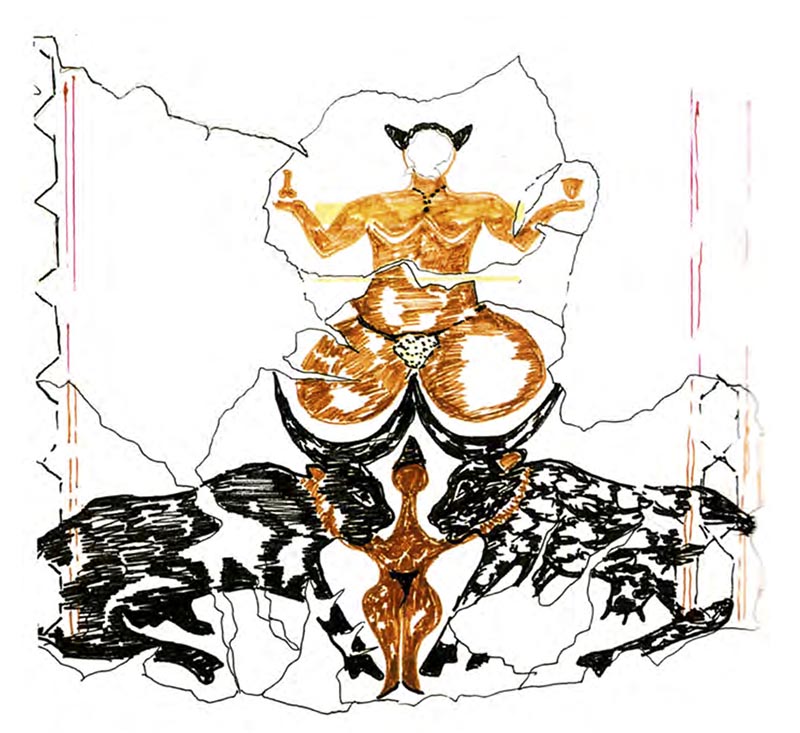
Mellaart had begun working in the Near East in the early 1950s, a wholly different era, perhaps even more primitive than the 1940s. Split into newly formed states with infrastructure degraded by war and neglect, movement was difficult. In the muddy Jordan Valley in early 1953 it was survey in advance of an infrastructure project that had brought Mellaart into contact with unique Chalcolithic and Early Bronze Age sites. It was this early work on which I wished to speak to him.
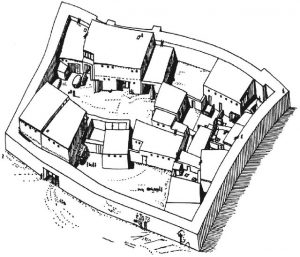
Hacılar IIA. Reconstruction of the fortified settlement. (Hacılar I, Fig. 22).
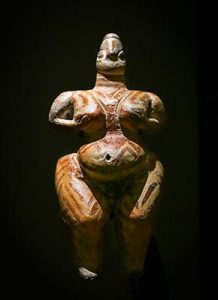
Hacılar figurine.
He had then worked at Jericho with Kathleen Kenyon. In his telling (to me at least) the excavation had encountered what appeared to be bedrock and Kenyon sought to cease digging. But Mellaart recommended they continue, thus piercing a thick plaster floor and discovering the Neolithic remains. He then headed to Turkey to do pioneering surveys and excavations of a Middle Bronze Age site, Beycesultan, and prehistoric sites, including Hacılar and Çatalhöyük.
Excavations at Hacılar revealed a dense village settlement of the sixth millennium, and famously, numerous female figurines and pots with human faces. His work at Çatalhöyük more famously still revealed an enormous settlement with almost city-like density, festooned with wall paintings, figurines, and wall ornaments that included animal skulls, human burials, and much more. These were among the first and most fantastic indications of the rich Neolithic cultures of Anatolia.
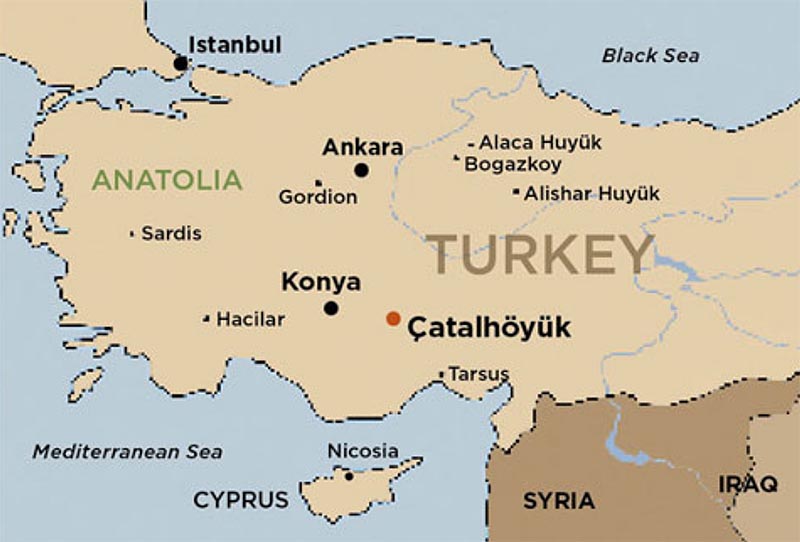

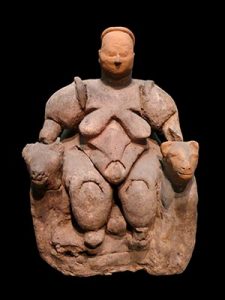
Çatalhöyük seated female figurine.
(https://upload.wikimedia.org/wikipedia/commons/6/6f/Museum_of_Anatolian_Civilizations_1320259_nevit.jpg)
After the class we retreated to his small office wherein I was subjected to three hours of intense discussion about prehistory and intense smoke from his small Dutch cigars. Students today will have difficulty imagining what it was like when smoking was allowed on campus, much less in faculty offices. I could hardly believe it myself and when we were done I sped to my B and B to frantically scribble notes and to scrub the smell out of my clothes and thick, lustrous hair and beard.
Few areas of the past were alien to Mellaart and we mostly spoke about the Levant. He had, a few years earlier, published an article arguing for a radical high chronology for the Early Bronze Age. This was dismissed but I was intrigued, and it turns out he was closer to the mark than anyone realized. He had many other useful insights and had recently completed a 100,000 word book synthesizing his views, or so he said.
But Çatalhöyük was the key. Oddly, when one searches today for references to the unpublished wall paintings, much less images, they are nowhere to be found, except in a rare book on Turkish textiles, a few online reviews, and two virtually unavailable pieces by Mellaart himself.* The wall paintings contained fantastic scenes but also geometric patterns that resembled Turkish flat woven textiles, kilims, and were thus, he claimed, evidence of continuity between the Neolithic and the present. But there were only reconstructions – the original drawings and photos had been destroyed when his in-laws’ house in Turkey had burned down, or so he said.
The best anyone can tell, in addition to the over 100 wall paintings recovered intact at Çatalhöyük, there had been many fragments of wall paintings that Mellaart over the years apparently reassembled and embellished into his own confections. As it happens, in 1965 Mellaart had been banned from the site he discovered and whose excavation he originally directed after a series of scandals, commencing with the ‘Dorak Treasure’ and culminating with thefts by workmen from the site. Work resumed only in 1993 and has continued since.
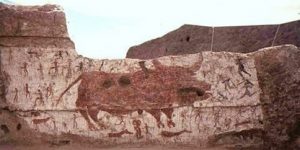
Wall painting of hunting scene.
The Dorak Affair was a literal episode of ‘Strangers on a Train,’ complete with Hitchcockian elements. Traveling from Istanbul to Izmir in 1958, Mellaart encountered a mysterious woman wearing an unusual piece of jewelry, or so he said. This led to several days examining a unique collection of third millennium objects. While the initial publication in the Illustrated London News caused a huge sensation, a 60,000 word scholarly manuscript had been prepared but has never been published.
But after receiving permission to publish the objects the next year it transpired that the mysterious woman’s address, and perhaps the woman and the objects themselves, were invented. Mellaart was later accused of smuggling, or aiding smugglers, or being duped by the CIA. He believed he had been set up by smugglers seeking to authenticate a hoard for export. A former colleague, however, later deemed it all an invention and a “dream like episode.”
My general rule is that things that seem too good to be true probably aren’t, except sometimes when they are. How are we to assess new and fantastic data? Must the possibility of fraud (the pretty name is scientific misconduct) require us to do a criminal background check on every scholar? And what is fraud anyway in archaeology? For all its pretenses to be a science, archaeology destroys many observations in the process of making them, rendering key assertions unreplicable.
The excavation experiment, so to speak, cannot be run again. In the process even basic observations can appear different to different individuals. Is that a floor or not a floor? Are those stones a wall? Someone has to decide. Truths (with a very small t) accumulate but with a variety of weak links. Objects, however, tend to persist even without their context, but are also regularly invented to supply a voracious market.
But in the case of Dorak and later the unpublished Çatalhöyük murals it is unclear the items ever existed at all. So it is with another phenomenon (this seems to be the best word for it) associated with Mellaart, the Beyköy tablets and inscription. The Beyköy tablets were allegedly three bronze tablets with Hittite cuneiform writing found in the 19th century in the village of the same name. After one was exhibited and then disappeared, the Sultan Abdulhamid II had the remaining two locked up in his palace. After the Ottoman Empire fell, the tablets reappeared periodically and were shown to Western scholars, eventually including Mellaart. Of course, all the previous scholars are long dead.
But there is also the Beyköy inscription. Apparently this immense Late Bronze Age inscription in the Western Anatolian language called Luwian tells of political relations between the kingdom of Mira, its vassals and outposts, as far away as Ashkelon on the southern Levantine coast, and the crisis created by the Sea Peoples, including the fall of the Hittite Empire.

The story goes on to claim that the 29 meter long (!) inscription was found in the mid 19th century and had been copied by a French archaeologist who left notes in the Ottoman archives, which were recovered in the 1950s by Turkish archaeologists, who planned to publish the texts along with Western scholars. They died, however, and the texts passed to Mellaart. Meanwhile the original copy had long since disappeared.
Much was hinted at by Mellaart as he worked on the texts, but he never actually published them in his lifetime. After Mellaart’s death in 2012 the questions about his unpublished (and published materials) became more intense. With the permission of his son, Swiss scholar Eberhard Zangger examined Mellaart’s study and storage spaces in London, a rare opportunity for an archaeologist to go from excavator to the excavated.
What Zangger found was troubling, indeed heartbreaking. Masses of notes and manuscripts, hundreds of drawings and even inscribed stones, attest to the past being manufactured, with pieces and stories being rearranged and perfected over decades.
Regarding the Beyköy tablets, Zangger and his coauthor Fred Woudhizen were shocked to find masses of notes detailing Mellaart’s ever shifting accounts; one tablet becomes two, then three, then 25, contradictions are introduced, forgotten then compounded, all to produce an imaginary geography of Anatolia, complete with hundreds of place names.
But as far as the long Beyköy inscription goes, Zangger and Woudhizen cautiously believed it to be real, but were crestfallen to find no evidence for the inscription’s existence outside of the wildly shifting accounts in Mellaart’s own files. It was, in the words of a former Mellaart student, a specialist in Luwian, “a gigantic fantasy.” At the same time, however, the text itself (known only from Mellaart’s drawings) appears to be so correct linguistically and historically that it might actually be real.
Here the questions are compounded geometrically. How could someone master an especially difficult and obscure extinct language to fake an especially long inscription using correct as well as idiosyncratic grammar, data such as place names, and even phrases that were not yet known to scholars? Did Mellaart take something ‘real’ and then inexplicably fake a backstory? How do we separate the inscription from the man? And if two of the world’s leading specialists think that it might be ‘real’ how are the rest of us to judge? There is no object to verify for market and only the tiniest cadre of specialists who can even evaluate the data. What is real anyway?
At this point we should also ask, does it matter? Scientific misconduct comes in many forms. Most dangerous are various types of biomedical fraud that potentially cost lives. A fake Luwian inscription or Neolithic wall painting cannot be so accused. Certainly goddess worshippers might be crushed to learn that imposing women did not have quite as prominent a place in Neolithic society as once asserted. But Late Bronze Age specialists, who aren’t convinced the Beyköy inscription is real in the first place and who enjoy arguing about the Sea Peoples regardless, are unlikely to be affected one way or another. This is not a large group.
Why do academics fake things? The most obvious reasons are fortune and glory. A glance at Retraction Watch shows that the most cited academic papers that have then been retracted are almost all in the biomedical fields, where the stakes in terms of lives and money are high, followed by social psychology. Shaping public policy by fraud should not be surprising as a motive, since academics are often by nature both manipulative and passive aggressive.
But where does faking Neolithic wall paintings or a Luwian inscription fit in? Academics demonstrating they are smarter than everyone else may begin as a form of personal satisfaction or revenge regardless of financial or professional reward. It is impossible to explain the selfishness and venality of some academics to outsiders – insert here the obsolete cliché about academic politics being so vicious because the stakes are so low – but the private satisfaction of vengeance is even more bizarre. Yet it happens.
But there is also a fantasy element at work, an impulse to create worlds as they should be, to fill in the gaps and extend ‘normal’ reconstruction into something beyond. All archaeologists at one time or another believe they have a kind of transcendent insight into ‘their’ period or place, and often into other people’s sites. There’s a story about the famous American archaeologist Lewis Binford visiting a prehistoric cave site in South Africa for the first time and then ignoring his hosts and walking around explaining that this activity happened here and that activity happened there. What had actually been found no longer mattered.
On the other hand, stealing Greek papyri from a university collection and selling them, in part to fulfill a market that wishes to reimagine the early history of Christianity, or forging Dead Sea Scroll fragments, makes fantasy profitable.** Alas, most archaeologists can’t seem to get in on the action.
Most of us don’t get that carried away with our fantasy lives in the first place, we just write unpublished novels or obsessively follow sports, travel, collect transistor radios, go to conferences, write the same articles over and over, or just dig endlessly, accumulating more and more stuff as if some day the data will speak for (and publish) themselves. But it speaks to the power of imagination and the necessity to use language to explain archaeological phenomena, translating observations into narratives. This is another reason why archaeology isn’t really a ‘science’ as such even as it uses scientific methods and results. It also may be a reason why scholars should relax a bit and maybe join a bowling league.
So how and where do we draw the line? What sort of evidence or ‘proof’ should we insist on regarding various claims? Does this autographed photograph of me with Bigfoot help? How do we distinguish between fraud and simply getting things wrong? As the band Little Feat once put it, (in another context) “some kind of man he can’t do anything wrong, if I see him I’ll tell him you’re waiting.” Archaeologists, like all scholars, make mistakes all the time but most are loath to correct themselves. But this generates one of archaeology’s cottage industries, ‘correcting’ other people’s work – parsing errors that can be observed only as two dimensional representations and words. Hey, it’s a living.
Perhaps ethics training for scholars should be ‘don’t get carried away and make up (too much) stuff’ and not ‘don’t ever get anything wrong.’ Archaeology is about taking fragmentary data and creating successive approximations of the past; inferences that fill in gaps and leaps of imagination that create plausible reconstructions are critical, as is creative use of language. But we should be pretty strict about the facts, the observations themselves. Who knows, maybe archaeologists should wear cop cams to record their every movement.
Ego and economics don’t help. Everyone wants to keep their best stuff on the down low until they can roll it out to great acclaim and for excited donors. But there are limits, and we should be suspicious of fabulous materials that don’t quickly see the light of day (as opposed to prosaic stuff that is boring to work on). In archaeology, as in most things, there often seems to be an inverse relationship between fabulousness and the truth. Except when there isn’t.
And what about Mellaart? Where do we draw the line? Nothing should detract from his monumental – and correctly documented – surveys, excavations and brilliant analyses, but inevitably there is an asterisk next to his name. How much sympathy should we have for the pioneering archaeologist and even for the fabulist, the latter at war with the former, who lost his site, his colleagues, and his reputation as he lost his grip? Maybe more than we think. The impulse to create tragedy, inner demons that destroy us as our lives both rise and the fall, are present in us all.
I finally got the cigar smell out and left London feeling that I had a remarkable encounter. If only I had known how remarkable.
Alex Joffe is editor of The Ancient Near East Today.
* I am grateful to Eberhard Zangger for providing me with copies of these items and for the images.
** Discerning readers will note here rather uncanny similarities with the renewed controversy regarding the Shapira Scroll, objects brought to light in the late 19th century by a known forger which then disappeared and that may, or may not, have been real Dead Sea Scrolls. I have no position but I think this falls into the category of things that make you go, hmm.
Want To Learn More?
The Origins of Maps in the Near East
By Bleda S. Düring
We live in a world of which every corner has been mapped, and in which we constantly use maps to navigate our way. Yet this use of maps is relatively recent. Maps originated in the ancient Near East but why aren’t there more? Read More
 Forging Ancient Texts
Forging Ancient Texts
By Heather Dana Davis Parker
For an accurate and complete understanding of history and culture, it is crucial that written sources be authentic. But what if they are not? The surest way to verify the authenticity of ancient documents is to determine if they were recovered from secure archaeological contexts. Read More



